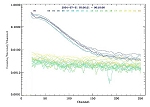No. 28 - First Lunar Resonance
The effect produced is similar to that generated during a planetary fly-by. Typically in a fly-by the closest approach of the spacecraft to the planet or moon takes place well within its sphere of influence (roughly 60 000 km radius for the Moon). In such a case the spacecraft acquires a major change in its trajectory from gravitational interactions with the larger body. This well-proven technique, which was first experimented with Mariner 10 in 1973, has been successfully used many times in different parts of the solar system.
SMART-1, however, was outside the sphere of influence of the Moon so experienced a low intensity gravitational disturbance to its orbit, rather than a major course correction. These regions, where more than one planetary body are affecting the flight of a spacecraft, are much more difficult to handle. These scenarios fall in the realm of multi-body dynamics, which have engaged several mathematicians for years and are still a matter for today's theoretical research. The ESA flight dynamics team, located at ESOC, used powerful computing techniques to analyse the problem to ensure the desired changes in altitude and argument of perigee.
These encounters will occur at regular intervals with each lunar orbit (period of 27.4 days). Because the Moon's orbit is fixed, the period of the SMART-1 orbit is altered to ensure the spacecraft is at apogee when close to the Moon. The SMART-1 orbit is, therefore, in "resonance" with that of the Moon.
| Encounter |
Ratio of Orbital Periods |
| 1 - 19.08.04 |
5:1 |
| 2 - 15.09.04 |
4:1 |
| 3 - 12.10.04 |
3:1 |
| 4 - 17.11.04 (Lunar Capture) |
2:1 |
Up to 25 August, at the 266th engine pulse, the SMART-1 electric propulsion system has cumulated a total ON time of nearly 3146 hours, consumed about 49 kg of Xenon and imparted to the spacecraft a velocity increment of about 2330 ms-1.
Science update
D-CIXS
The D-CIXS instrument has observed cosmic sources for calibration (such as Sco-X1) as well as for monitoring the variability of X-ray binaries. In addition the D-CIXS instrument measured the Earth's X-ray atmospheric fluorescence during one of the Earth scans on 17 August. The D-CIXS team will meet at Rutherford Appleton Lab on 2 and 3 September to discuss these results and prepare for the lunar phase.
|
D-CIXS X-ray spectrum obtained for the bright calibration source SCO-X1 in the range from 1.5 to 10 keV. |
 |
Future Activities
The next lunar resonances are scheduled for 15 September and 12 October. Lunar capture is planned for 17 November. Electric propulsion should then resume on 20 November for spiralling down into a polar lunar orbit with 300 km perilune and 3000 km apolune. Lunar commissioning is planned to start in mid-January 2005, and lunar science operations in February 2005.
A presentation of the SMART-1 mission and science results will be given at the British Festival of Science (7 September, Exeter) in the session "Physics and Chemistry of the Earth: Past, Present and Future".
The SMART-1 plasma working group will meet at ESTEC on 16 September to discuss the measurements of the plasma instruments EPDP and SPEDE in relation to the operations of the Ion propulsion, measurements of natural plasma from the Earth to the Moon, and lessons learned for the future.
SMART-1 will celebrate its first year in space on 27 September, and the Science and Technology Working Team will hold a workshop on 26-27 October to review the technology demonstration, cruise results and future lunar science payload planning.
Orbital/Trajectory information
The osculating orbital elements are periodically computed by the ESOC specialists. These elements define the so called "osculating orbit" which would be travelled by the spacecraft if at that instant all perturbations, including EP thrust, would cease. So it is an image of the situation at that epoch. In reality the path travelled by the spacecraft is a continuous spiral leading from one orbit to another. The most recent osculating elements are as follows:
|
EPOCH (UTC) 2004/08/25 00:00:00 Elements WRT Earth (J2000) |
|
| Pericentre Distance (km) |
37 791.260752 |
| Apocentre Distance (km) |
240 824.362870 |
| Semi Major Axis (km) |
139 307.824770 |
| Eccentricity |
0.728721 |
| Inclination (deg) |
6.939815 |
| Asc. Node (deg) |
93.599264 |
| Arg. of Pericentre (deg) |
253.095940 |
| True Anomaly (deg) |
172.310009 |
| Osc. Orbital Period (h) |
143.738051 |
In this diagram the osculating orbits at launch (GTO) and at different times are plotted. The large effects on the orbit expansion, that the combination of the operations of the electric propulsion together with the Moon encounter have, are clearly visible. The Moon effects are mainly in the increase of the perigee altitude and in the rotation of the line of apsides (change in argument of perigee).
 |
|
SMART-1 osculating orbit up to 25 August 2004 |
Since the start of the mission the orbital elements have been changed by the ion-engine and the first lunar resonance as follows:
- The semi-major axis from 24 626 km to 139 307 km
- The perigee altitude from 656 km to 31 413 km
- The apogee altitude from 35 880 km to more than 230 000 km
- The orbital period from 10 hours 41 minutes to nearly 6 days
Contact Points
Giuseppe Racca
SMART-1 Project Manager
ESA/ESTEC - SCI-PD
Keplerlaan 1- 2200 AG Noordwijk, The Netherlands
E-mail: Giuseppe.Racca esa.int
esa.int
Bernard H. Foing
SMART-1 Project Scientist
ESA/ESTEC - SCI-SR
Keplerlaan 1- 2200 AG Noordwijk, The Netherlands
E-mail: Bernard.Foing esa.int
esa.int

